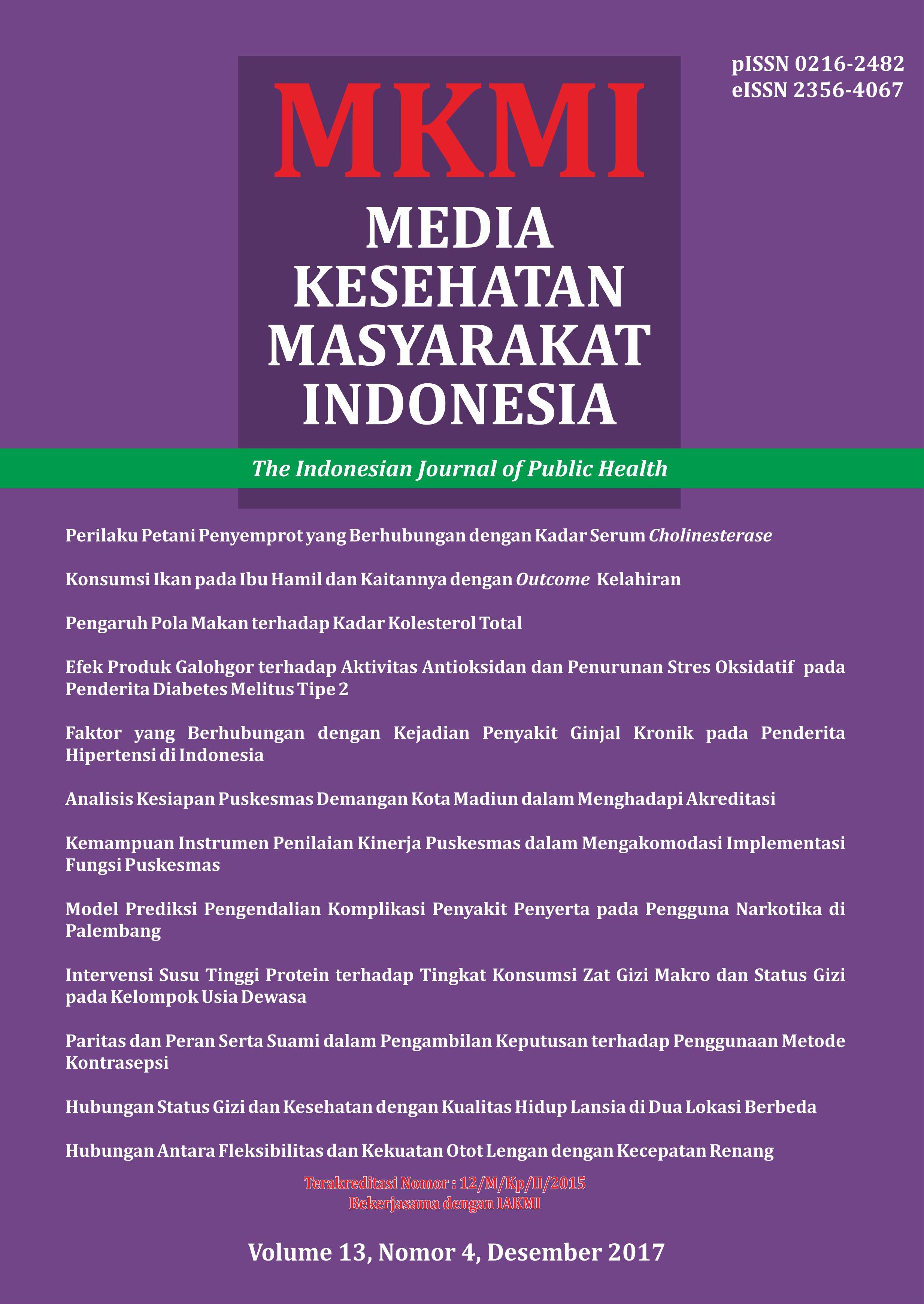INTERVENSI SUSU TINGGI PROTEIN TERHADAP TINGKAT KONSUMSI ZAT GIZI MAKRO DAN STATUS GIZI PADA KELOMPOK USIA DEWASA
Abstract
References
Istiany, A, Rusilanti. Gizi Terapan. Bandung (ID): PT Remaja Rosdakarya; 2003.
Kementerian Kesehatan Republik Indonesia. Badan Penelitian dan Pengembangan Kesehatan Riset Kesehatan Dasar 2013. Jakarta (ID): Balitbangkes; 2013.
Ha, E, Zemel, MB. Functional Properties of Whey, Whey Components, and Essential Amino Acids: Mechanisms Underlying Health Benefits for Active People. The Journal of Nutrtional Biochemistry. 2003;14(5):251-258.
Anderson, G,H, Luhovvy, Akhavan, T, Panahi, S. Milk Proteins in the Regulation of Body Weight, Satiety, Food Intake and Glycemia. Physiologic Functions of Milk Proteins. 2011;67:147-159.
Lien, TK, Nhung, BT, Khan, NC, Hop, LT, Nga, NTQ, Hung, NT, Kiers, J, Shigeru Y, Biesebeke, RT. Impact of Milk Consumption on Performance and Health of Primary School Children in Rural Vietnam. Asia Pac J Clin Nutr. 2009;18(3):326-334.
Setiowati A. Pengaruh Diet Tinggi Protein terhadap Indeks Massa Tubuh, Persen Lemak Tubuh, Kekuatan Otot dan Kecepatan pada Atlet [Skripsi]. Semarang (ID): Universitas Diponegoro; 2013.
Marshall K. Theraupetic Applications of Whey Protein. Alternative Medicine Review. 2004;9(2):136-186.
Tripton, KD, Elliott, TA, Cree, MG, Wolf, SE, Sanford, AP, Wolfe, RR. Ingestion of Casein and Whey Proteins Result in Muscle Anabolism after Resistance Exercise. Journal of the American College of Sports Medical. 2004;36(12):2073-2081.
Diepvens, K, Berer, H, Plantenga, W. Different Proteins and Biopeptides Differently Affect Satiety and Anorexigenic/Orexigenic Hormones in Healthy Humans International Journal of Obesity. 2007;32:510–518.
Aimutis W.R. Bioactive Properties of Milk Proteins with Particular Focus on Anticariogenesis. J.Nutr. 2004; 134:989S-995S.
Pal, S, Ellis, V, Dhaliwal, S. Effects of Whey Protein Isolate on Body Composition, Lipids, Insulin, and Glucose in Overweight and Obese Individuals. British Journal of Nutrition. 2010;104:716-723.
Krissansen G.W. Emerging Health Properties of Whey Proteins and their Clinical Implications. Journal of the American College of Nutrition. 2007;26(6):713S-723S.
Patel S. Functional Food Relevance of Whey Protein: A Review of Recent Findings and Scopes Ahead. Journal of Functional Food. 2015;19(1):308–319.
Mitchell, CJ, McGregor, RA, Souza, RFD, Thorstensen, EB. Markworth, JF, Fanning, AC, Poppitt, SD, Cameron-Smith, D. Consumption of Milk Protein or Whey Protein Results in a Similar Increase in Muscle Protein Synthesis in Middle Aged Men. Nutrients. 2015;7(10):8685-8699.
Lameshow, S, Hosmer, DW, Klar, J, Lwanga, SK. Besar Sampel dalam Penelitian Kesehatan. Yogyakarta (ID): Gadjah Mada University Press; 1997.
Benelam B. Satiation, Satiety and their Effects on Eating Behaviour. British Nutrition Foundation Nutrition Bulletin. 2009;34(2):126–173
Bray, G,A, Smith, S,R, Jonge, L,D, Xie, H, Rood, J, Martin, CK, Most, M, Brock, C, Mancuso, S, Redman, LM. Effect of Dietary Protein Content on Weight Gain, Energy Expenditure, and Body Composition During Overeating A Randomized Controlled Trial. JAMA. 2012;307(1):47-55.
Tieland, M, Dirks, ML, Zwaluw, NVD, Verdijk, Rest, OVD, Groot, LCPGMD, Loon, LJCV. Protein Supplementation Increases Muscle Mass Gain During Prolonged Resistance-Type Exercise Training in Frail Elderly People: A Randomized, Double-Blind, Placebo-Controlled Trial. Journal of the American Medical Directors Association. 2012;13(8): 713–719.
Benatar, JR, Jones, E, White, H, Stewart, RAH. A Randomized Trial Evaluating the Effects of Change in Dairy Food Consumption on Cardio- metabolic Risk Factors. European Journal of Preventive Cardiology. 2014;21(11):1376– 1386.
Nagpal, R, Behare, P, Rana, R, Kumar, A, Kumar, M, Arora, S, Morotta, F, Jain, S, Yadaw, H. Bioactive Peptides Derived from Milk Proteins and their Health Beneficial Potentials: an update. Food & Function. 2011;2(1): 18-27.
Hernandez-Alonso, P, et al. High Dietary Protein Intake is Associated with an Increased Body Weight and Total Death Risk. Clinical Nutrition. 2016;35(2):496-506.
Abargouei, AS, Janghorbani, M, Salehi-Marzijarani, M, Esmaillzadeh, A. Effect of Dairy Consumption on Weight and Body Composition
in Adults: a Systematic Review and Meta- analysis of Randomized Controlled Clinical trials. International Journal of Obesity. 2012; 36(1):1485-1493.
Grodner, M, Roth, SR, &Walkingshaw, BC. Nutritional Foundations and Clinical Applications. United State of America: Elsevier; 2012.
Almatsier, S. Prinsip Dasar Ilmu Gizi. Jakarta (ID): Penerbit PT Gramedia Pustaka Utama; 2009.
Yulni. Hubungan Asupan Zat Gizi Makro dengan Status Gizi pada Anak Sekolah Dasar di Wilayah Pesisir Kota Makassar. Media Kesehatan Masyarakat Indonesia. 2013;9(4):207-213.
Katan, MB, Ludwig, DS. Extra Calories Cause Weight Gain. But How Much?.JAMA. 2010;303(1): 65-66.
Authors
Authors retain copyright and grant the journal right of first publication with the work simultaneously licensed under a Creative Commons Atribusi-NonKomersial-BerbagiSerupa 4.0 Internasional License that allows others to share the work with an acknowledgement of the work's authorship and initial publication in this journal.
Copyright encompasses rights to reproduce and deliver the article in all form and media, including reprints, photographs, microfilms and any other similar reproductions, as well as translations. The reproduction of any part of this journal, its storage in databases and its transmission by any form or media, such as electronic, electrostatic and mechanical copies, photocopies, recordings, magnetic media, etc.
All articles published Open Access are free for everyone to read and download. Under the CC-BY-NC-SA license, authors retain ownership of the copyright for their article, but authors grant others permission to use the content of publications in Media Kesehatan Masyarakat Indonesia Universitas Hasanuddin in whole or in part provided that the original work is properly cited. Users (redistributors) of Media Kesehatan Masyarakat Indonesia Universitas Hasanuddin are required to cite the original source, including the author's names, Media Kesehatan Masyarakat Indonesia Universitas Hasanuddin as the initial source of publication, year of publication, and volume number.
Media Kesehatan Masyarakat Indonesia Universitas Hasanuddin is licensed under Creative Commons Atribusi-NonKomersial-BerbagiSerupa 4.0 Internasional.


